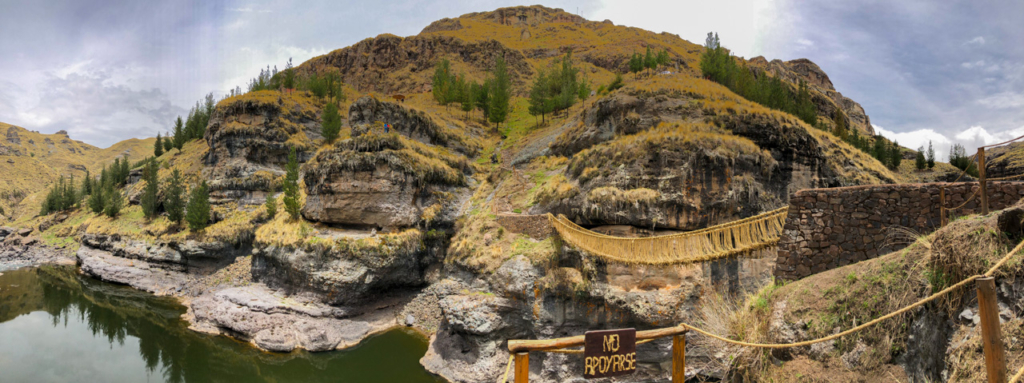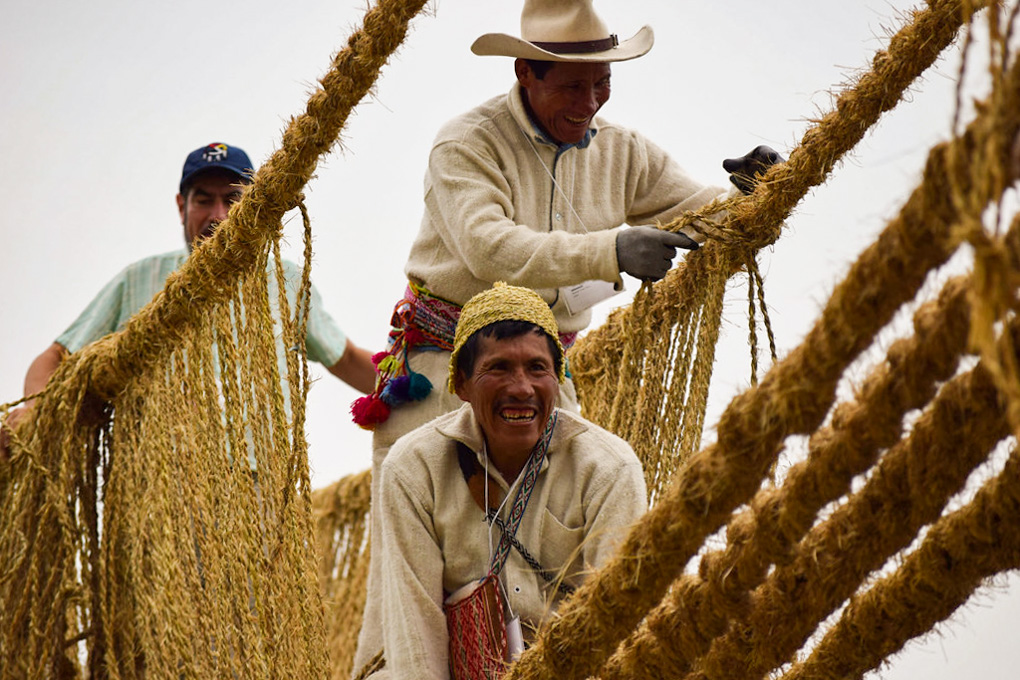
The ancient Inca Empire was known for being one of the most opulent, encompassing a large part of South America. For the Incas, the challenge was to connect the rugged territory with the towns of the empire and for this they used stone or wooden bridges. But the most amazing technique to make a bridge was to make them out of plant fiber. In this blog we will talk about the last Inca bridge Q’eswachaka and the story of a community that refuses to abandon its customs 500 years after the Spanish conquest.

During the time of the Incas, there was a large road system called the Qhapaq Ñan that linked the vast territory of Tahuantinsuyu of more than 30,000 km, covering parts of the current countries of Peru, Ecuador, Bolivia, Colombia, Chile and Argentina. To cross this rugged geography, suspension bridges made of plant fibers were built. The Incas were great engineers, and the Q’eswachaka is proof of their skill that has endured throughout the centuries. Located in the Cusco region and the province of Canas, it is one of the few bridges with this infrastructure that has survived and is still in use.
The process begins days before, when the villagers go out to collect the q’oya (a type of grass that grows in the Andes) to make 70 meters of Q’eswa. After collecting the q’oya, they are spread out in the sun to dry and work with them.
On the day of the renovation there is a great movement of people where more than 1000 people from 4 communities come together to build the bridge for 3 days. Apart from the ropes that each family must deliver, during the construction of the bridge ropes are constantly woven, especially by women.
A commission is in charge of counting the amount of rope delivered. Then it is time for the Chakaruwak (master builder specialized in the ancestral technique of weaving rope bridges) to direct the work, they cut, braid and replace the old bridge with a new one.


You will witness the wonder of traditional engineering and a great cultural experience. Since visitors can observe the process of this construction in the month of June or walk on the bridge at any time of the year. In addition, the area is full of landscapes including the nearby lakes (Pomacanchi, Acopia, Asnaqocha and Pampamarca), it is the ideal place for nature lovers and rural tourism.
The tour to the Q’eswachaka bridge is a one day tour, you can arrange the pick up from your hotel with the agency at 4 am, in a trip of approximately 2 hours you will arrive at Cusipata for breakfast, you will continue the tour visiting the 4 lagoons (Pomacanchi, Acopia, Asnaqocha and Pampamarca) you will continue towards the historical towns and the Q’arañahui cave. After this tour we will arrive at the Q’eswachaka bridge. We will return to Cusipata for lunch and we will be in Cusco between 6 and 7 pm.
Comfortable clothing: Bring warm, comfortable clothing for walking, as the weather can be unpredictable.
Appropriate footwear: The terrain can be rough in places, so sturdy sneakers are recommended.
Camera: The landscapes and the bridge itself are highly photogenic, perfect for capturing memories.
Hydration and snacks: Bring water and some snacks, as there aren’t many places to shop around.
Respect traditions: If you visit during the bridge’s renovation, remember to be respectful of local customs.
The Q’eswachaka bridge is a relic and a living tradition that connects people today with the heritage of the Incas. Visiting the bridge is to witness history and learn about Andean culture, while enjoying breathtaking landscapes.
Yes, the bridge is safe. Although it is made of q’oya (plant fiber), the communities renew it annually. However, if you suffer from vertigo it can be a challenging experience as the bridge sways slightly.
You can visit the bridge throughout the year, but the best time may be in June during the bridge’s renovation ceremony. However, if you prefer a quieter atmosphere you can visit anytime outside of these dates.
It is not mandatory to hire a guide, but it is recommended if you want to learn more about the history and traditions surrounding its construction. Our tour includes a guide, transportation, breakfast, lunch and a visit to some nearby places.
There is no fixed cost, but some local communities may request a contribution that goes towards maintaining the bridge.
Yes, the weather in the area is cold, especially during the mornings and nights. It is recommended to wear warm clothing in layers, a raincoat and sunscreen since the sun can be strong.
Yes, most tours to the Q’eswachaka bridge last one day. At Inka Altitude we specialize in one-day tours.
Crossing the Q’eswachaka Bridge is a unique experience, but it can be challenging if you are afraid of heights, especially at times when the bridge sways in the wind or when you walk. But it is completely safe.
There are no official camping areas near the bridge, but there are some areas you can use for camping with permission from local communities. It is best to arrange this with an agency to follow local regulations.
No, due to the uneven terrain and bridge structure, the hike requires some skill in navigating dirt trails and up and down hills.
The four lakes: Pomacanchi, Acopia, Asnaqocha and Pampamarca. You can also explore the local communities.









Search
